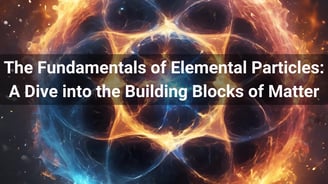The Fundamentals of Elemental Particles: A Dive into the Building Blocks of Matter


The pursuit of understanding the most basic constituents of the universe has not been given up on by the scientific community. The most fundamental building blocks of matter from which everything in the observable universe is made have hence, become elemental particles. The characteristics, classification, and forces that govern the interaction of such elements are what are discussed in this paper on the wondrous world of elemental particles.
What are Elemental Particles?
Elemental particles are subatomic particles that cannot be broken down into smaller components by any known physical means. They are the building blocks of atoms, which in turn form molecules, compounds, and all matter that we interact with. These particles are incredibly small, with dimensions that are a fraction of the size of an atom, and they operate in a realm governed by the principles of quantum mechanics.
Classification of Elemental Particles
Elemental particles can be broadly divided into two main categories: fermions and bosons.
Fermions
These are the particles forming matter. These particles follow the Pauli Exclusion Principle, that is, no two fermions can be in the same quantum state simultaneously. Quarks and leptons classify further into the category of fermions.
Quarks: Quarks are the constituent particles of protons and neutrons, found within the atomic nuclei. In total, there are six flavors of quarks: up, down, charm, strange, top, and bottom.
Leptons: Leptons are elementary particles that do not have any interaction with the nuclear force. The electron is by far the most famous lepton. Two other leptons known besides the electron are the muon, the tau, and their respective neutrinos.
Bosons
Bosons are particles that mediate the fundamental forces of nature. There is no restriction or rule in the case of bosons to obey the Pauli Exclusion Principle and can be at the same quantum state. The most familiar boson is the Higgs boson, which is generally linked with the Higgs field that gives mass to other particles.
The Fundamental Forces
There are four significant forces in nature that describe the interactions of particles at the element level: gravitational, electromagnetic, strong nuclear, and weak nuclear forces.
Gravitational Force: It is the weakest of the four forces but infinite in range. It is the attraction of two masses.
Electromagnetic Force: This force operates between charged particles and causes electricity, magnetism, and light. It is much stronger than gravity and infinite in range also.
Strong Nuclear Force: The strongest of the forces, it acts between quarks and holds the nuclei of atoms together. Its range is limited to the size of an atomic nucleus.
Weak Nuclear Force: It does all the work for radioactive decay and neutrino interactions, with a very short range and weaker than both the electromagnetic and strong nuclear forces.
The Standard Model of Particle Physics
The Standard Model is a theory that describes the behavior of elemental particles and the forces that act upon them. It is a well-tested framework that explains how these particles interact and the symmetries that govern these interactions. A significant milestone was the discovery of the Higgs boson in 2012 at the Large Hadron Collider (LHC), confirming the existence of the Higgs field predicted by the Standard Model.
Challenges and Future Prospects
The Standard Model is incomplete despite its success. It does not contain the force of gravity and cannot explain dark matter and dark energy, which account for much of the mass and energy in the universe. The quest for a 'Theory of Everything' that would unite all fundamental forces and particles continues to be at the heart of physics.
Conclusion
For truly understanding the more profound questions pertaining to the nature of the universe, elemental studies form the primary nucleus. Aided by ongoing advancements in the technological sector of this study area, scientists dig deeper into what lies in quantum reality and progressively close in toward solving the conundrums embedded in the secrets of the cosmic universe. Their quest for such knowledge remains active and continuously accelerates their process of knowing because each new development brings them yet closer to greater mystery.
References
